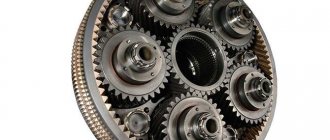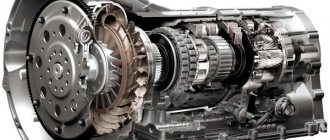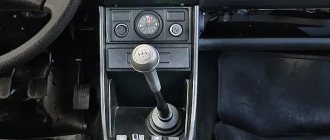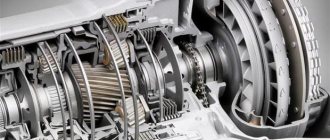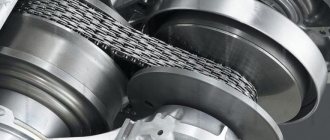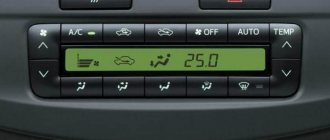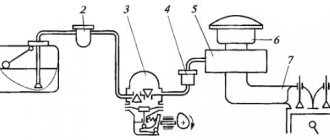Adaptive automatic transmission and other types of gearboxes
The concept of an adaptive gearbox rather refers not to the gearbox itself, but to the shift control. It is understood that the automatic machine adapts to the driver’s driving style and thereby provides him with the most comfortable driving conditions. This is made possible by using electronics to control the switching process.
An adaptive gearbox or, one might say, an automatic transmission, when choosing the best switching mode, takes into account the following factors:
- acceleration style (forced or calm);
- preferred driving mode, when it is carried out with a constant position of the gas pedal, the automatic machine selects a higher gear, providing an economical mode;
- preferred acceleration mode; when accelerating with maximum acceleration, the automatic transmission uses a sports gear shift program;
- Preferred braking mode: when you press the brake sharply, the automatic uses sports braking with an earlier transition to lower gears.
Thus, after some time (up to tens of minutes), the adaptive automatic transmission begins to change gears in a mode that best suits the driver’s usual pace of movement and driving style. Only such a box has a significant, but easily overcome drawback. After driving for a long time in difficult conditions, for example in a traffic jam, the adaptive transmission remembers this mode and carries out further shifts as if driving in a traffic jam.
Therefore, after the traffic jam is left behind, the car may lose its usual dynamics and will have to be “taught” again in the mode of movement you need. This is done very simply - you just need to drive at the right pace for several tens of minutes, and everything will be restored.
However, the described machine is not an exclusive option for constructing an automatic transmission. For example, a car may use a sequential gearbox. The essence of its operation is that the switch is made to the next gear in order, up or down, i.e. From fourth gear you can switch to fifth or third. As a rule, such a machine is installed on racing cars.
Unlike what a sequential gearbox allows, a manual transmission allows you to set the desired gear from any position, for example, from third to fifth.
It is also worth noting that the machine, when operating, uses a set of programs that determines in which mode it is necessary to switch. These include programs that allow you to implement sports shifting, winter driving mode, uphill and with a load (trailer).
An adaptive automatic transmission allows the driver to free himself from the procedure of manual gear shifting; in addition, the automatic transmission creates and maintains driving conditions that are most comfortable for the driver when driving.
What is the difference between regular and adaptive machines?
And everything is simple here. Ordinary automatic transmissions are programmed for a certain gear shift (different manufacturers have different ways), but the essence is the same - they set the shifts at 2500 rpm and it switches to them, there are no lower economical rpms for you, nor are there any increased ones. Manufacturers, of course, install various simulating modes - such as ECO (economical), SPORT (sports), OD (overdrive), etc., but all of these are essentially manual adjustments of the machine, no adaptation, all by hand!
Adaptive automatic machine, does not need buttons or settings, does not need any modes; it will remember everything and adjust it itself. That’s why on such machines there are a minimum of buttons, like mine, look at the photo, there is no sports, no economy mode!
If you like to “save”, then it will get used to it; if you like to “drive”, after a certain mileage it will switch at higher speeds.
As I wrote above, you can determine such an automatic machine yourself, using a minimum of buttons and modes on the lever and the blog next to the automatic transmission handle. Well, in terms of changing behavior.
Now we are watching a short video.
That's all, I think my article was useful for you, tell your friends about it on social networks, this is the best gratitude for our blog.
( 12 votes, average: 4.92 out of 5)
Similar news
Automatic transmission clutches. What are they, how do they work and why do they burn?
Double clutch. What is it, the basic principle of operation. Plus .
I engaged reverse gear at speed - WHAT WILL HAPPEN? Let's take the car apart.
What can such a box do?
- It takes into account the speed at which the driver accelerates and the speed at which he most frequently travels. Gear shifting is carried out taking these features into account.
- The electronics calculates the driver’s favorite driving mode, in which the driver “accelerates” for the longest time. In such situations, the gear is switched to a higher gear to make movement more economical.
- When accelerating at the highest acceleration rate, gear shifts begin in a sporty manner.
- If sudden braking occurs, the transmission switches to a lower gear and uses the capabilities of the so-called sports braking.
- Among other things, the electronics monitor the degree of wear of automatic transmission parts.
Why adaptation is required
Adaptive automatic transmissions differ in that their design provides for the use of a special electronic unit. With its help, the transmission gets used to it, that is, it adapts to the driving style of a particular motorist. This allows you to create an ideal connection between the speed of the power unit and the gear shift.
From here the answer becomes obvious about why this adaptation is needed. This is a way to create the most comfortable and favorable conditions for driving a vehicle in various modes, conditions and when traveling at different speeds.
All this is provided by electronics, which are responsible for several functions simultaneously:
- Accelerating dynamics. The box allows you to create the fastest and sharpest acceleration, or smooth and calm. The automatic transmission monitors the speed at which acceleration occurs most frequently;
- Travel mode. If the position of the foot on the gas pedal does not change, that is, the pressure on the accelerator remains unchanged, the automatic transmission switches to higher gears and saves fuel;
- Acceleration. When the driver tries to accelerate sharply, the box automatically starts the program in sports mode;
- Braking. If the driver suddenly presses the brake pedal to the floor, which is considered sports braking, the electronics force the transmission to drop down several gears at once;
- Wear. In parallel, the task of the adaptive box is to monitor the degree of wear of the assembly elements.
All this allows you to make the operation of the box clear, thoughtful and adapted to a person’s driving style. This makes it possible to understand in many ways what adaptive automatic transmission means and what its main features are.
But it is necessary to understand in more detail the essence of such equipment. To really understand what this adaptive automatic transmission is, you should study its structure and operating modes.
Basic adaptation parameters
Most modern automatic transmissions do not have special buttons for switching modes. This makes driving easier for the car owner. The main thing is that the chip with the program embedded in it works properly in the automatic transmission.
The machine remembers:
- driving style. The automatic transmission independently adjusts to engine operation and responds to frequent pressing of the pedal by the driver’s foot. Protects against excessive fuel consumption, which can occur as a result of constant changes in speeds;
- acceleration dynamics. The automatic transmission remembers how the driver likes to start and repeats these actions next time. As a result, the driver receives smooth control of the car without jolts or jerks;
- braking style. If the car owner likes to brake sharply, then the box resets three gears immediately after pressing the pedal. These actions go unnoticed by the driver.
The automatic transmission can recognize winter conditions. For example, if the wheels slip, winter mode is activated. Understands when the car is moving uphill. During this process, a lower gear is engaged.
Device Features
Much in terms of design and device depends on the specific automaker. Competition forces the introduction of some proprietary solutions that distinguish the box of one manufacturer from another.
But if we talk about what an adaptive automatic transmission is, then we should take into account certain similarities between all similar automatic transmissions. The first step is to use a torque converter. It includes paddles mounted on 3 wheels. Gear drives are also used, the majority of which are planetary.
The true difference and the main essence of adaptive devices lies in the electronics. The electronic units have approximately the same design, some look almost identical. But each manufacturer has its own set of programs, filling and electronic brains.
Operating modes
As noted earlier, the automatic adaptive transmission adapts to the driver's specific driving style. Depending on acceleration, braking, acceleration, intensity of operation of the gas and brake pedals, the electronics selects the required optimal mode.
Moreover, the operation of such transmissions can be carried out in several of the most common modes:
- economical;
- sports;
- winter
Each of them has its own characteristics.
- Economical operating mode. If the driver adheres to a moderate driving style with his vehicle, the electronics switches to economy mode. The main objective of this mode is maximum fuel economy. During operation of the car, smooth and gradual acceleration is observed, the car does not move away when you press the gas pedal. Mostly the automatic transmission electronics select lower gears. A relevant mode for those who often drive in urban environments, are forced to sit in traffic jams, face heavy traffic and comply with speed limits;
- Sports mode. For more aggressive drivers who like to accelerate quickly and drive at high speeds, the electronics provide the option of switching to a sport program. It is aimed at forced control, the fastest possible acceleration, and excellent dynamics. In addition to quickly accelerating, in this mode the car will also brake quickly. When switching to the vehicle's sport mode, the adaptive transmission extracts full power from the engine. As a result, the car starts quickly and actively gains maximum speed. In parallel, this leads to increased fuel consumption. There is no longer any talk about any priority for saving fuel;
- Winter operation mode. An extremely useful and effective option for adaptive automatic transmission programming. With its help, the car adapts to movement on the road surface, which is characterized by the presence of a layer of snow or ice. Special programs allow the car to start moving almost without slipping. At the same time, acceleration and braking are moderate, without sudden jerks and kicks. At the same time, the program includes the possibility of an emergency stop. Here the braking is carried out by the engine. This function is aimed at reducing the braking distance when braking on a slippery surface. In winter mode, there is no clear priority for automatic transmission gears. The only exception can be called the start. In this state, the adaptive gearbox prefers to start off primarily in 2nd or 3rd gear.
What is automatic transmission adaptation and why is it needed?
The concept of adaptation in a broad sense means the adaptation of an object to changing external and internal conditions.
In relation to cars, this term means adjusting the operation of the automatic transmission depending on the individual driving style, the corresponding operating modes of the engine and brake system, the operating time and degree of wear of the mechanism parts. For a hydromechanical transmission, the adaptation procedure is based on adjusting the settings of the automatic transmission electronic control unit (ECU). The memory device contains logical programs that receive information from sensors or control units of other systems. The input parameters for the ECU are the rotation speed of the crankshaft, output shaft and turbine, the position of the gas pedal and the Kick-Down switch, the oil level and temperature, etc. The commands generated in the ECU are transmitted to the actuators of the hydraulic transmission control unit.
Sectional view of a hydromechanical gearbox.
Earlier automatic transmission models were equipped with permanent storage devices that did not allow changes to the control algorithm. The possibility of adaptation was realized by the development of reprogrammable memory devices used on almost all modern automatic transmissions.
The automatic transmission ECU programmer is configured to take into account many different operating parameters, the main ones for adaptation being the following:
- The dynamics of acceleration, expressed in the sharpness of pressing the gas pedal. Depending on it, the adaptive automatic transmission can be configured for a smooth, maximally extended gear shift or for an accelerated one, including jumping over steps.
- The driving style to which the program reacts based on the frequency of changes in the gas pedal position. When the accelerator is in a stable position while driving, higher gears are engaged to save fuel; in “ragged” driving mode in traffic jams, the automatic switches to lower gears with a decrease in the speed.
- Braking style. With frequent and sharp braking, the automatic transmission is configured to quickly reset gears; the manner of smooth braking corresponds to smooth gear shifting.
Although the process of adapting the operation of a hydromechanical automatic transmission using the ECU occurs in a constant mode, in some cases it is necessary to reset existing settings and reconfigure parameters. This procedure is recommended to be performed when there is a change of owner (driver), in case of incorrect operation of the unit, or after repair, if the oil was changed during troubleshooting.
Resetting the previous adaptation to the ECU.
Experienced drivers practice reconfiguration when switching from the winter stage of operation to the summer stage and vice versa, when returning from long trips to the urban cycle, after traveling with a maximum vehicle load by weight.
For robotic gearboxes, the purpose of adaptation is to adjust the operating mode depending on the degree of wear of the clutch disc. It is recommended to carry out this procedure periodically as planned, if malfunctions occur in its operation, after transmission repairs are completed. Individual driving style in this case is more likely to serve as a reason for diagnosis and adaptation.
Adaptation time
Car enthusiasts are quite rightly interested in the issue of adaptation speed. That is, the time period required for the transmission to get used to and adapt to certain operating conditions.
The adaptation time directly depends on the specific manufacturer of the boxes and the electronics used. Boxes can be roughly divided into 2 categories:
- Automatic transmission, where adaptation takes literally a few minutes or occurs after several kilometers traveled. The driver drives a certain distance or drives for some time in a calm or aggressive mode. The machine gets used to this and switches to the appropriate operating program;
- Other transmissions use accumulated information. They accumulate algorithms, collecting data over a fairly impressive period of time or over a large number of kilometers. Some boxes can adapt based on the last 300-1000 kilometers. Having stored the information in the electronic unit, the computer begins to switch between modes, depending on the specific situation. Such automatic transmissions are the most difficult to learn.
Each category of adaptive machines has its own advantages. The first can quickly get used to new conditions, but at the same time it often provokes discomfort in the event of a sudden change in operating mode. In the second situation, you need to wait longer for full adaptation, but then the box will clearly understand how to behave.
How to adapt an automatic transmission
Taking into account the above, the adaptive automatic transmission “takes into account” a number of parameters while driving (how hard the driver presses the gas, what acceleration is needed, how braking occurs, at what speeds the vehicle usually moves, etc.). After this, the electronics forces the box to operate in the mode most suitable for the particular driver and his driving style.
In fact, such adaptive boxes are quite a convenient solution, since they often relieve the driver of the need to switch to sport mode, engage manual gear shifting using the Tiptronic function, etc.
The only drawback can be considered certain complications associated with the operation of the automatic transmission ECU and algorithms, as well as the fact that when another driver gets behind the wheel, difficulties and even inconveniences may arise. It should also be noted that in non-standard situations, the adaptive box may also not behave quite “correctly”.
For example, if the driver is accustomed to aggressive acceleration and a jerky driving pace with constant acceleration and deceleration, in a traffic jam the adaptive transmission can strongly “tear” the car forward even with gentle pressure on the gas. We also recommend reading the article about what a Tiptronic automatic transmission is. From this article you will learn how the Tiptronic gearbox differs from other types of automatic gearboxes, as well as what are the pros and cons of this type of unit.
The reason is that the automatic transmission has “remembered” the driving style and is trying to provide active acceleration. Also, if the car was moving in a traffic jam for some time, and then drove out onto an unloaded road, you may feel that the car accelerates worse.
Again, while driving in traffic jams, the automatic transmission adapted to new driving conditions, that is, shifts are now adjusted precisely to such conditions (smooth acceleration, frequent braking, low speeds).
It is important to understand that to “retrain” an automatic transmission it takes about 10-20 minutes or, on average, you will need to drive about 10-15 km (depending on the brand, model, type of automatic transmission, etc.). To achieve the desired result, the driver needs to drive at the desired pace for several minutes so that the box adapts again.
It is for this reason that when checking a car with an automatic transmission (for example, a used car with an automatic transmission is purchased), the adaptive box may switch for some time with jerks, jerks, etc. The reason in this case may not be one or another malfunction of the machine, but the fact that the transmission ECU has not yet been rebuilt for the new driver.
To evaluate the performance of the adaptive automatic transmission, you just need to drive the car in the usual manner, after which you can draw certain conclusions.
Automatic transmission training
As I mentioned above, training depends on many parameters, as well as on the very structure of the machine and its electronics (algorithms).
On one, you just have to pull out of a traffic jam and press the gas for a few minutes (dynamic driving) and it will switch from a vegetable to a sporty ride.
But there is training when you need to carry out special manipulations, because the algorithm is calculated based on the last, say, 200 kilometers. You bought such a car, but it doesn’t work for you, it’s better to reset everything to factory settings.
- The first option is the dealer, he will be able to reset the adaptation. And even upload other factory firmware. BUT this is not the case for all manufacturers.
- As they call it on the forums – “collective farm training”. This is when several different manipulations seem to reset the adaptation, for example - turn on the ignition - hold the gas pedal (30 seconds) - then the brakes (30 seconds) - release and turn off the ignition. It is reliably known that this is how Mercedes is chipped in. Here is an example video.
Self-reset adaptation, contact specialists
Each model of adaptive automatic transmission requires compliance with a certain procedure for zeroing (resetting) adaptation. So, for an automatic transmission of the 722.6 series (Mercedes’s own production), to reset the adaptation it is enough:
- turn the ignition key two clicks (without starting the engine);
- press the gas pedal all the way for 30 seconds;
- turn off the ignition, wait five minutes (without opening the doors);
- remove the key, press the accelerator;
- start the engine.
Automatic transmission adaptation reset
The most common way to reset automatic transmission adaptation is as follows:
- You need to start by warming up the engine to a “working” state. There is no need to take any action yet;
- Then you need to turn off the engine for 5 seconds and start it again;
- Wait until the engine speed reaches 2.5 thousand - 3 thousand. in a minute;
- Turn off the engine again for 5 seconds and start the engine again;
- While holding the brake, turn on each speed in turn;
- Connect the dealer tester and do a reset;
- Start a smooth movement;
- Carefully, smoothly pick up speed to 40 km/h, and after 1 minute slowly stop the car;
- Turn off the engine, then start it;
- Carefully, smoothly pick up speed to 80 km/h, after 1 minute slowly stop the car;
- Turn off the engine, then start it;
- Drive at different speeds for 20 minutes (40 km/h, 80 km/h, driving on a straight road at the same speed)
- Wipe (wash) any oil that has come out from the bottom of the gearbox;
- Ride from 5 to 20 kilometers without particularly loading the engine;
- See if oil is leaking from the gearbox seals and other places;
- If necessary, raise the oil level to the lower hot level;
More on the topic: What is better than original spare parts for Hyundai Solaris?
How to care for adaptive automatic transmission?
Like any gearbox, the adaptive automatic transmission does not require long and diligent care. Do not forget that, in fact, this is one of the types of slot machines.
All that is required of you is to fill in the transmission fluid appropriate for the type of your gearbox on time. And it’s better to do this in advance, before problems with the mechanism begin.
The fact is that another disadvantage of the adaptive gearbox is the insufficient capabilities for its proper maintenance. In Russia, especially in small towns of the country, the possibilities of searching, purchasing and replacing parts are far from wide. Because of this, repairs may require a lot of time (due to ordering devices) and money.
Why is the adaptive automatic transmission slow?
Many people will now ask that they bought a car. Former owners said that the adaptive automatic transmission was configured. And after traffic jams, there is no acceleration dynamics. Or, conversely, on the highway it goes dynamically, but when entering the city and after several minutes of city mode, it starts to become “dull” again.
The fact is that the automatic machine adapts to a certain driving mode: in a traffic jam or in city mode. Therefore, the option of setting up the machine yourself is sometimes not effective.
And, to avoid such stupidities, I would recommend that the automatic transmission be adapted through chip firmware in specialized workshops.
Advantages and disadvantages
There is no limit to perfection. And the current adaptive boxes are certainly far from ideal. It will still take quite a lot of time to achieve optimal results in the operation of these transmissions.
If we talk about current adaptive machines, we can highlight several main advantages:
- The ability to create comfortable conditions during the operation of the vehicle;
- Speed switching is carried out in certain programmed algorithms, when choosing one of which the speed of movement, the condition of the surface, the intensity of pedaling, etc. are taken into account;
- Modes change independently. The driver does not need to press any buttons or levers;
- Minimum number of buttons and controls on the box;
The ability to reduce fuel consumption, which is ensured by the selection of gears and operating modes.
But not everything is so perfect. Adaptive automatic transmissions have their drawbacks. The main disadvantage is the imperfection of the adaptation system, which is not always able to correctly adapt to the driver’s requirements. This is clearly manifested when one driving mode is replaced by another. For example, when the driver was moving in slow, dense traffic, and then drove onto an open highway and wanted more dynamics. Or vice versa. It takes some time to rebuild and adapt, sometimes measured in several minutes or kilometers.
Also, the adaptive system does not always show its best side when driving on bad roads, where there are rather sharp transitions from normal surfaces to various uneven surfaces, bumps and holes that need to be avoided and maneuvered.
Another drawback is the issue of maintenance. In Russian conditions, there are some problems with maintenance and finding spare parts. Since adaptive automatic transmissions are actually a type of automatic transmission, but with more complex electronics, finding and purchasing some parts can be problematic. This requires more time and financial resources.
Adaptive gearbox video
In the following video you can see how to use an automatic transmission. There is nothing complicated in it, everything is simple and clear. So, pay attention to the screen:
Using the machine you can move quickly and conveniently both in the city and outside it. Of course, a manual transmission allows you to shift as you please, but an automatic makes it easier to drive and frees you from constantly having your hand on the gearshift lever.
Conclusion: an adaptive transmission is an automatic transmission with special electronics that remembers the driver’s actions, shifts gears in a convenient style and simplifies driving.
